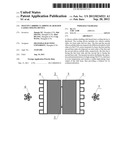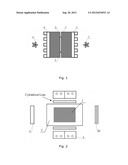Patent application title: SILICON CARBIDE CLADDING SLAB BASED LASER COOLING DEVICE
Inventors:
Jianqiu Xu (Shanghai, CN)
Rui Zhang (Shanghai, CN)
Rui Zhang (Shanghai, CN)
Jinzi Huang (Shanghai, CN)
Cong Wang (Shanghai, CN)
Assignees:
Shanghai Jiao Tong University
IPC8 Class: AF28F1300FI
USPC Class:
165121
Class name: Heat exchange with impeller or conveyor moving exchange material mechanical gas pump
Publication date: 2012-09-20
Patent application number: 20120234521
Abstract:
A silicon carbide cladding slab based laser cooling device is disclosed.
The cooling device includes two silicon carbide slabs, two heat sinks and
two fans. The first and the second silicon carbide slabs are respectively
diffusion bonded to both sides of a Nd:YVO4 active material of a
laser; the first and the second heat sinks are disposed on outer sides of
the first and the second silicon carbide slabs, respectively; the first
fan is facing the first heat sink and the second fan is facing the second
heat sink. The present invention facilitates the operation and
miniaturization of a high-energy Nd:YVO4 slab laser at room
temperature and ensures a stable high-energy laser output of the slab
laser, thus providing a solution for its commercialization.Claims:
1. A cooling device for a laser having a Nd:YVO4 active material,
comprising: a first and a second silicon carbide slab, diffusion bonded
to both sides of the Nd:YVO4 active material respectively; a first
and a second heat sink, respectively disposed on an outer side of the
first and the second silicon carbide slabs; and a first and a second fan,
respectively facing the first and the second heat sinks.
2. The cooling device according to claim 1, wherein: the first silicon carbide slab, the first heat sink and the first fan are configured to be coaxial with the second silicon carbide slab, the second heat sink and the second fan, respectively.
3. The cooling device according to claim 1, wherein: the first and the second silicon carbide slabs have a larger size than the Nd:YVO4 active material to form silicon carbide claddings.
4. The cooling device according to claim 1, wherein: the first and the second heat sinks are copper blocks with micro-grooves formed on outside surfaces, inner surfaces of the copper blocks being closely connected with the first and the second silicon carbide slabs respectively.
Description:
CROSS-REFERENCES TO RELATED APPLICATIONS
[0001] This application claims the priority of Chinese patent application number 201110060968.X, filed on Mar. 15, 2011, the entire contents of which are incorporated herein by reference.
FIELD OF THE INVENTION
[0002] The present invention relates to a device used in the field of optical instrument and in particular, relates to a silicon carbide cladding slab based laser cooling device.
BACKGROUND
[0003] Nowadays, liquid cooling is commonly used as a cooling method for laser devices. Although liquid cooling is effective, it is complex and inconvenient for design and experiment. In design, paths of cooling liquid, airtightness and other aspects must be taken into account; during the experiment, such problems as requiring a bulky cooling liquid circulating device and appropriately arranging the liquid pipelines bring great inconvenience, and also increase the complexity of experiment system design and affect the stability of operations.
[0004] A liquid cooling method is disclosed in the publication by Hamish Ogilvy, Michael J. Withford, Peter Dekker and James A. Piper, entitled "efficient diode double-end-pumped Nd:YVO4 laser operating at 1342 nm", published as Optics Express 11, 2411 2003. However, this method is relatively complex and inconvenient for design and experiment.
[0005] The disclosed device is directed to solve one or more problems set forth above and other problems.
BRIEF SUMMARY OF THE DISCLOSURE
[0006] An objective of the present invention is to provide a laser cooling device to facilitate the operation and miniaturization of a high-energy Nd:YVO4 slab laser at room temperature and to ensure a stable high-energy laser output of the slab laser, so as to provide a solution for its commercialization.
[0007] The present invention is implemented by the following technical solutions. A device for cooling a laser having a Nd:YVO4 active material, the device comprising a first and a second silicon carbide slab, a first and a second heat sink, as well as a first and a second fan, wherein the first and the second silicon carbide slabs are diffusion bonded to both sides of the Nd:YVO4 active material, respectively; the first and the second heat sinks are soldered on the outer sides of the first and the second silicon carbide slabs, respectively; the first fan is facing the first heat sink and the second fan is facing the second heat sink.
[0008] The first silicon carbide slab, the first heat sink and the first fan are configured to be coaxial with the second silicon carbide slab, the second heat sink and the second fan, respectively.
[0009] The first and the second silicon carbide slabs both have a larger size than the Nd:YVO4 active material to form silicon carbide claddings.
[0010] The first and the second heat sinks are copper blocks with micro-grooves formed on their outside surfaces, and their inner surfaces are closely connected with the first and the second silicon carbide slabs respectively.
[0011] Laser diode pump beams are introduced into the Nd:YVO4 active material from its side faces, and the heat generated during the experiment is rapidly transferred to the heat sinks through the silicon carbide slabs having a high conductivity and is quickly dissipated from the whole system by the fans, thus achieving a highly efficient cooling. As the experiment device is designed to be completely symmetrical, the system only generates a temperature gradient in a vertical direction perpendicular to the surfaces of the active material, and the heat is rapidly dissipated from the system along the vertical direction, thereby minimizing the harm of thermal stress to the experiment device and forming a basis for stably and efficiently producing high-energy laser beams.
BRIEF DESCRIPTION OF THE DRAWINGS
[0012] FIG. 1 shows a schematic diagram of the structure of the laser cooling device according to the present invention;
[0013] FIG. 2 shows a schematic diagram of the structure of a laser.
DETAILED DESCRIPTION
[0014] Reference will now be made in detail to exemplary embodiments of the invention, which are illustrated in the accompanying drawings. Wherever possible, the same reference numbers will be used throughout the drawings to refer to the same or like parts.
[0015] As shown in FIG. 1, the laser cooling device according to one embodiment of the present invention includes: a first silicon carbide slab 2, a second silicon carbide slab 3, a first heat sink 4, a second heat sink 5, a first fan 6 and a second fan 7, wherein the first and the second silicon carbide slabs 2 and 3 are diffusion bonded to both surfaces of a Nd:YVO4 active material 1 of a laser, respectively; the first and the second heat sinks 4 and 5 are respectively disposed on the outer sides of the first and the second silicon carbide slabs 2 and 3; the first fan 6 is facing the first heat sink 4 and the second fan 7 is facing the second heat sink 5.
[0016] The first silicon carbide slab 2, the first heat sink 4 and the first fan 6 are coaxial with the second silicon carbide slab 3, the second heat sink 5 and the second fan 7, respectively.
[0017] The first and the second silicon carbide slabs 2 and 3 both have a larger size than the Nd:YVO4 active material 1 to form silicon carbide claddings.
[0018] The first and the second heat sinks 4 and 5 are copper blocks with micro-grooves formed on their outside surfaces, and their inner surfaces are closely connected with the first and the second silicon carbide slabs respectively.
[0019] As shown in FIG. 1 and FIG. 2, the Nd:YVO4 active material 1 is pumped from its side faces by laser diodes 8. A resonant cavity is formed by a reflecting mirror 9 and an output coupling mirror 10. By sandwiching the Nd:YVO4 active material 1 between the silicon carbide slabs 2 and 3 which have a high thermal conductivity, the heat generated by the active material 1 during the laser producing process is rapidly transferred to the heat sinks 4 and 5 disposed on both sides, and is further dissipated from the experiment device by the fans 6 and 7 beside the heat sinks 4 and 5. By utilizing symmetrically designed structures on both sides of the active material 1, the direction of temperature gradient in the material is corresponding to the normal line direction of both surfaces of the active material 1, and the heat is rapidly transferred along this direction by the silicon carbide slabs 2 and 3 to reduce the influence caused by thermal stress to the system, thus achieving high-energy laser output at room temperature without using liquid cooling.
[0020] The present invention can achieve 100-watt-level laser output at room temperature by using special materials. The fact that the thermal conductivity of silicon carbide is very high while its thermal expansion coefficiency is very close to that of Nd:YVO4 provides a basis for the present invention. There are many deficiencies in diffusion bonding the Nd:YVO4 active material to a conventional copper heat sink, for example, the active material is extremely easy to distort and even fracture under thermal stress when it is heated; besides, the copper will absorb a part of the pump beam and thereby reducing the absorption efficiency of the pump beam. The present invention adopts silicon carbide slabs, on the one hand, the Nd:YVO4 active material can be closely diffusion bonded to the silicon carbide slabs by way of diffusion bonding to effectively transfer the waste heat. Since these two materials have similar thermal expansion coefficiencies, heat distortion of the active material is coincide with that of the silicon carbide slabs when the active material is heated, therefore, the fracture of the active material and the diffusion bonding layers can be effectively avoided. On the other hand, as silicon carbide material has an excellent optical property, the pump beam can transmit in the completely transparent silicon carbide material, thus resolving the issue of beam absorption existed in conventional copper heat sinks, and in this way, increasing the absorption efficiency and laser output efficiency of the system. Moreover, as the outside surfaces of the silicon carbide slabs are in complete contact with the copper heat sinks, waste heat is transferred to the copper heat sinks by the silicon carbide materials with high thermal conductivity, and further, as the copper heat sinks have micro-grooves on outside surfaces, air flow provided by the fans can sufficiently contact with copper heat sinks and carry the waste heat off the experiment device, so as to ensure a high-energy laser output. Compared with conventional liquid cooling experiment devices, the present invention can obtain a high-power laser output by using a simplified structure, which shows the advantages of novel air cooling devices.
User Contributions:
Comment about this patent or add new information about this topic:
| People who visited this patent also read: | |
| Patent application number | Title |
|---|---|
| 20210019899 | IMAGING DEVICE, DISTANCE MEASUREMENT METHOD, DISTANCE MEASUREMENT PROGRAM, AND RECORDING MEDIUM |
| 20210019898 | SCENE CAMERA RETARGETING |
| 20210019897 | METHOD, APPARATUS, AND SYSTEM FOR PROVIDING REAL-WORLD DISTANCE INFORMATION FROM A MONOCULAR IMAGE |
| 20210019896 | Coding Distance Topologies for Structured Light Patterns for 3D Reconstruction |
| 20210019895 | FLUORESCENCE IMAGE REGISTRATION METHOD, GENE SEQUENCING INSTRUMENT, AND STORAGE MEDIUM |


